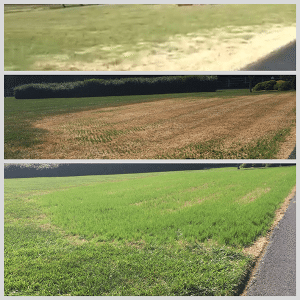
Hi folks!
For seven years, I overlooked it.
Literally.
As I scooted my wheelchair up and down my driveway to walk the dog, get the mail, or pick up my morning newspaper, the toleration glared at me.
Bermuda grass.
It didn’t bother me as much in the summer or in the winter when it blended in with the fescue grass that was supposed to rule my lawn. But in the transition seasons, when it refused to grow as quickly in the spring or die as slowly in the fall as the rest of its neighboring grass, it annoyed me. The lazy brown patches among the lush green fescue irritated me.
Daily.
The words of my father, who practically manicured his lawn year round, kept playing in the back of my mind. “That’s Bermuda grass,” he’d say when we would pass lawns peppered with burnt-looking spots. “It can take over your lawn. Fast growing. You can’t crowd it out, either. You have to kill it at the roots.”
Each spring and fall I’d remember, sigh, and then naively hope it would go away.
But it didn’t.
Now to be honest, the grass is not to blame—it’s just its nature. In fact, in the right environment—golf courses, Florida lawns, and croquet fields—it is fabulous.
But in my area of the country and in my yard in particular, it was a pest. An eye-sore. An invasive weed that intruded on some of my very favorite parts of the day.
One year I asked my lawn care company what I should do. They said to seed over it with more fescue and fertilize it heavily.
Skeptical but willing, I tried it for two years.
And the patch got larger.
Another company offered to dig it up for me and replace it with sod.
But that price tag didn’t fit my budget.
So I tolerated it. And year by year I watched a small patch become a full-blown twenty-yards-long-and-almost-as-wide menace.
Finally, I’d had it. I called the landscaping professionals who’d helped me rid my gardens of thistle and asked them what to do. They recommended a specialized lawn care company who knew how to eliminate Bermuda grass.
Guaranteed.
I like guarantees.
And after calling the company, they said if I switched my lawn care service to them, they would do it for free. I like free.
Especially when it’s guaranteed.
But most of all, I liked their plan. First they would kill all the Bermuda grass—twice. Then they would aerate and replant plugs of fescue.
“Your lawn will not be pretty for a while,” they warned me. “It’s necessary because we have to make sure the roots are dead before replanting.”
Don’t you love it when “really-want-to-trust” matches “always-have-trusted” advice? I could just hear my father saying, “Yep, B-B, this will work.”
And it did.
 I couldn’t believe the relief I felt when I got rid of that toleration. I never knew how much space it was taking up. Now my strolls up and down the driveway are pleasant. Even inspiring.
I couldn’t believe the relief I felt when I got rid of that toleration. I never knew how much space it was taking up. Now my strolls up and down the driveway are pleasant. Even inspiring.
Perhaps tolerations are energy zaps, like all those windows I keep open on my desktop computer or all those aps I have running on my iPhone. Too many open and idle tasks are taking up space in the background, slowing down response times and even the ability to open up new windows or applications.
What once annoyed me now energizes me. Those sprouting fescue plugs work just as well as my Starbucks cappuccino.
Well, almost.
How about you? What energy-zappers have you shut down lately? Were you energized, too?
I’d love to know.
Thanks for reading. Thanks for sharing. Oh, and this Saturday is my Scared Spitless debut. Thoughts, prayers, and well-wishes are greatly appreciated.
My best—always,
Becky
Sign Up Here, if you’d like to receive Thoughtful Thursdays via email.
Wow. Good post. Given the drought conditions here, I couldn’t help thinking it would be nice to have a lawn at all, but then I loved the way you worked in the life lesson. My current energy-zapper? Negative thinking. Man, that one is hard to turn around.
Thanks, Anne! Appreciate your thoughts, and yes, negative thinking can be a drain. Sorry for the delay here. My best to you! Becky